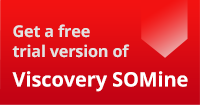市場および財務分析
Segmentation in banking using self-organizing maps: A case study of business customers
Jukovic, Pejic Bach, Dumicic and Šarlija (2012) Conference Proceedings of 6th International Conference of the School of Economics and Business Beyond the Economic Crisis: Lessons Learned and Challenges Ahead, eds. Mehic, Eldin (Ekonomski fakultet u Sarajevu) 767-778
The foundations of SOM and, in particular, of the SOM-Ward clustering algorithm, as introduced by Viscovery, are presented and demonstrated in an application for market segmentation. Viscovery SOMine was used to cluster a data set of business clients of Croatian banks into three groups in order to derive relevant marketing activities.
A comparison of supervised and unsupervised neural networks in predicting bankruptcy of Korean firms
Lee, Booth and Alam (2005) Expert Systems with Applications 29(1):1-16
In this study, two learning paradigms of neural networks, supervised versus unsupervised, are compared in terms of prediction accuracy in the area of bankruptcy prediction. The back-propagation (BP) network was used as representative type for supervised networks and the Kohonen self-organizing feature map (Viscovery SOMine) was used as the representative for unsupervised neural networks.
Bewertung von Investmentfonds mittels Self-Organizing Maps (German language)
Wirtz (2005), Bachelor Thesis, Business School of Finance & Management, Frankfurt, Germany
Am Beispiel des deutschen Marktes für Investmentfonds untersucht diese Arbeit, inwieweit die nach Feri TRUST klassifizierten Fonds tatsächliche Ähnlichkeiten aufweisen.
Viscovery SOMine wurde für die Bewertung von Investmentfonds benutzt.
The self-organizing map in financial benchmarking
Eklund (2004) Dissertation, Institute for Advanced Management Systems Research, Åbo Akademi University, Åbo, Finland
In this dissertation, a self-organizing map (SOM) model for financial benchmarking in the international pulp and paper industry has been built on the basis of seven financial ratios measuring different aspects of financial performance. Viscovery SOMine was used to automatically identify the clusters at a two-level clustering using Ward’s method.
Forecasting of credit classes with the self-organizing maps
Merkevicius, Garšva, and Simutis (2004), 124X INFORMACINES TECHNOLOGIJOS IR VALDYMAS 4(33):61-66
The capabilities of SOMs in forecasting of credit classes were investigated. Viscovery SOMine was used to generate a model of credit units by similar characteristics of the process to determine credit classes. It is shown that SOMs may distinctly reduce misclassification errors.
European financial cross-border consolidation: at the crossroads in Europe? By exception, evolution or revolution?
Abraham and Dijcke (2002) Société Universitaire Européenne de Recherches Financières, Vienna, Austria
In the context of the new economics of banking, crossborder financial consolidation from the point of view of bank strategies was analyzed. A sample of the 100 largest banking groups in Europe was selected on the basis of the Bankscope data. This sample was presumed to be composed of subgroups with similar characteristics, which can be discovered by statistical analysis, using clustering techniques. Clustering identifed peer groups.
An empirical evidence of the financial performance of lean production adoption: a self-organizing neural networks approach
Biscontri and Park (2000) IEEE-INNS-ENNS International Joint Conference on Neural Networks (IJCNN'00) 5:5297
A feasibility study was performed to evaluate the application of self-organizing mapping neural networks (SOMs) to examine the financial performance of the U.S. lean production firms. Using control group design, the ability of SOMs to distinguish the financial performance between members of the target group (lean firm) and control group (non-lean firm) was tested. The financial performance we investigate includes return on assets (ROA), current ratio, and the ratio of cost of goods sold to sale, gross profit ratio, asset turnover, and inventory turnover ratio. Results show that the SOMs models successfully identify the financial performance of the lean firms from non-lean firms with quantization error of less than 0.01.
An Economic Analysis of Government Transfers with Viscovery SOMine
Shibata, Sakai, Takemitsu and Mochizuki (2000) Faji Shisutemu Shinpojiumu Koen Ronbunshu 16:403-404
Central government financial transfer to local government is analyzed using Viscovery SOMine.
Credit Rating Prediction using Self-Organizing Maps
Tan (2000) Master thesis, Erasmus University Rotterdam, The Netherlands
The relationship between the financial statement of a company and its assigned credit rating was analyzed to show how much of a company’s rating is affected by the qualitative analysis performed by the rating agency. Self-organizing maps were used to visualize large datasets and gain insight. Viscovery SOMine was used for credit rating predictions.
Marketing Mix Decision Making Using Scanner Data and Self-Organizing Maps
Krycha and Kranner (1998) Proceedings of 2nd Slovak Conference on Artificial Neural Networks (SCANN98), Smolenice, Slovakia
A self-organizing maps application was proposed to address the problem of managing the product line with respect to price decisions. Viscovery SOMine was used for the analysis of price elasticity.


